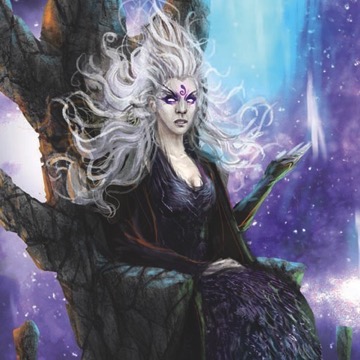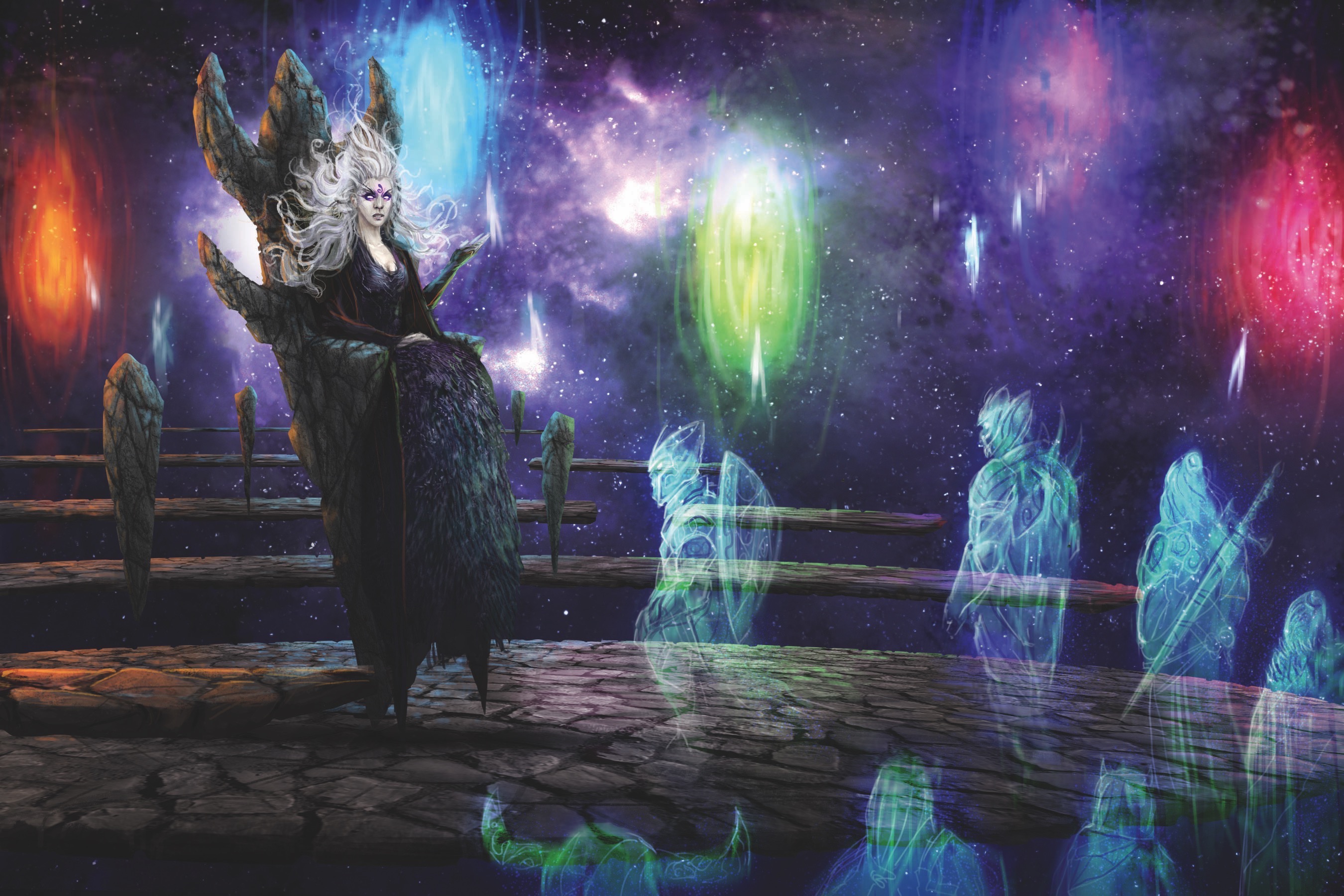“Reality is born. Reality must die. So somewhere in between must dwell both you and I.”
Such was said to be writ upon the Seal, carved in such a way that all would understand regardless of language or intellect. The Seal was the gravestone of the previous reality. The Seal was the foundation stone of the next reality. It was upon the Seal that Pharasma was born into this reality, adrift in the Maelstrom within an unformed metacosmos. She stood, and read the Seal’s Truth, and saw that she trod upon its core. Looking out over the Seal’s eight edges, Pharasma beheld the eternity of probability, a vastness yet formed from the raw entropy of the churning remains of what had come before. She was the Survivor, yet she knew not what she had survived—just that she had.
Pharasma stepped off the edge of the Seal, and as her foot descended to the nothing, the Seal expanded so that she was supported. She stood there a moment on one of the Seal’s eight edges, one step into the new reality, and she could sense that she was already not alone. Something chewed and gnawed out there beyond perception. Something vast, and hungry, and dangerous. Pharasma knew her first fear that very first step—fear of the unknown, fear that something else had survived, fear that she would not.
And so she stepped to the side.
As Pharasma walked, the edges of the Seal grew. The Outer Sphere bloomed beneath her feet as the Seal expanded its power. Where Pharasma walked, the planes themselves followed, and with each circuit around the Seal, she widened her path, walking a deosil spiral of creation that gave those who would follow a place to love and hate, to war and create. As she walked the spiral, the Seal itself grew outward, forming the Spire. It reached toward what lay opposite its beginning. And when Pharasma finished, the Spire had grown to support the Boneyard above, and it would be her home.
The Seal had responded to Pharasma’s spiral path, and as she strode, other divinities were birthed into the new reality. The Speakers in the Depths retreated at once to the heart of entropy and could not be bothered to take part in what followed. Desna marveled at creation, and with a wave of her hand brought the first night to the skies above. Sarenrae followed swiftly thereafter, and was smitten with Desna and her work, and so she chose the brightest of those stars to shine as the suns, birthing the first day. Ihys, who would in time become the First to die, and his brother Asmodeus, who would in time become the First to kill, each defined the other and brought goodness and evil with them. And Achaekek rose to stand between, an arbiter over morality and a judge whose impartial aegis would, in time, crumble to savagery. Yet not all of the first would have names, or even be remembered. One tread forth beyond the Eclipse, but without death yet in the world, this Prince became Bound to a throne in the Spire’s shadow to await his time. And the final would foolishly step forth beyond Pharasma’s first fearful step, and in so doing would be transformed and absorbed by that fear. Whether that fear became Rovagug or whether it was Rovagug who was the devouring fear, not even the gods can remember.
As those First Eight became, so did Pharasma feel something else wake on the far side of time. Just as she had walked a deosil spiral to create, a widdershins spiral wound in opposition at the other side of reality, where the Lurker at the Threshold formed the second anchor of creation. Pharasma thus learned that each cycle required not only a Survivor, but also a Watcher. So that between the two, between Pharasma and Yog-Sothoth, all reality would thus become the Great Beyond. Thus began the Age of Creation.
And so in the ages that followed, Pharasma remained upon her throne. She watched and judged all who passed from life into death, and as time wore on the number of the dead grew apace to the number of the born. And in time, Pharasma beheld her second fear. An event beyond anticipation fractured fate, and on all worlds, the flow of prophecy was forever altered. Storms raged, empires fell, gods died, and in the least fortunate corners of reality, entire worlds came to an end. Pharasma herself lost track for that brief moment of what had yet to come, and when she opened her eyes again, she saw that the Seal had vanished, leaving behind a featureless void. She reached out to the Watcher to inquire if such a ripple in destiny had ever occurred before, to determine if the loss of the Seal had always been ordained, but the Watcher would not reply.
Yet reality went on. Mortals were born, and mortals were slain. Pharasma’s second fear abated, and she realized that the lost Seal was not an ill omen, but more akin to the passing of a parent or teacher. Now, this cycle of reality had matured to the point where it could continue on its own, and Pharasma knew that, going forward, reality was well and truly on its own. The apogee of creation had passed, and Pharasma knew that her days ahead would forever be in the shadow of her days behind. And while she knew how much time remained, she knew as well that there was more than enough for mortal life to enjoy more glories and triumphs than they could envision.
And even though reality must eventually end, Pharasma does not despair. She knows that the number of the dead has never before eclipsed the number of the born, for even as the Watcher witnesses from outside the cycle, there must always be a Survivor to carry on within the cycle to begin the next. In time, the flux of the born shall cease, and their number shall become a static record. And in those final hours, Pharasma knows she must prepare the next cycle’s Seal, and she must watch and wait as the final count of the dead approaches. And when that final visitant from life steps before her throne to be judged, Pharasma knows that it will be the Survivor who stands before her, and that she will not judge but will herself be judged. And so, with her death, shall this cycle end.
But it is here that Pharasma’s final fear awaits. The fracture of fate and the loss of the Seal has made her conviction falter, and she no longer knows for fact that she shall be the penultimate death. For if she steps before herself to be judged, and leaves behind none to Survive, the cycle shall end and nothing shall wend.
About the Author
James Jacobs is the Creative Director for Pathfinder. While he was there at the beginning of Golarion’s creation, many of the deities worshiped by that world’s heroes and villains had already existed for decades before. Goddesses and gods like Desna and Rovagug, Sarenrae and Abadar, Achaekek and Zon-Kuthon first established their faithful among PCs and NPCs alike in James’ home campaign in the late 80s and early 90s. Sharing them with the world as deities of the Pathfinder setting, seeing players and creators come to love and hate them (and in some cases cosplay as them), has been a career highlight.
About the Windsong Testaments
On the northern reaches of Varisia’s Lost Coast stands Windsong Abbey, a forum for interfaith discussion tended by priests of nearly twenty faiths and led by a legacy of Masked Abbesses. At the dawn of the Age of Lost Omens, Windsong Abbey suffered as its faithful fought and fled, but today it has begun to recover. A new Masked Abbess guides a new flock within, and the Windsong Testaments—parables about the gods themselves—are once again being recorded within the abbey’s walls. Some of these Testaments are presented here as Golarion’s myths and fables. Some parts may be true. Other parts are certainly false. Which ones are which is left to the faithful to decide.









